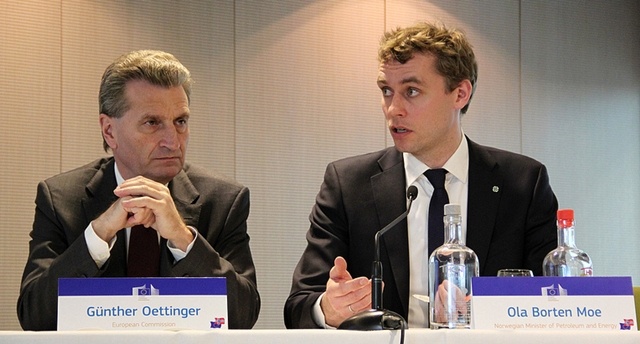The EU and Norway: Interdependence and Rivalry

Oettinger and Borten Moe talking gas. Photo: Lars-Erik Hauge
A recent poll in Norway revealed that the percentage of the Norwegian population which favors EU membership is at an all-time low. At the same time, the EU’s influence on Norwegian politics has never been as extensive as it is right now. This is especially true for the developments in the Norwegian Arctic, where European engagement leads to both limitations and opportunities.
The EU-debate in Norway currently is, and has been during recent years, almost non-existent in media and national politics. Although almost 70 percent of all adopted Norwegian legislation comes from the EU through the EEA-agreement (European Economic Area), the debate about Norway’s connection to the EU is lacking in society at large.1) The agreement, which was signed in 1994 when Norway rejected EU-membership by national referendum, has been named as a “political sleeping pillow” by commentators, hindering a proper debate on Norway’s relationship to Europe.2) And as recent polls show, 72 percent of the population is currently against a Norwegian EU membership, while only 12 percent supports it.3)
The Norwegian Government has established a committee to review the EEA-agreement and other aspects of the Norway-EU relationship, but its findings have not caused much debate. On the other hand, when talking about the Arctic (the Norwegian Arctic = Nordområdene), EU-politics has led to reactions, albeit mostly negative. Following the European Parliament’s 2008 reference to a resource moratorium for the Arctic, and the extensive deliberation in both the Commission and the Parliament on the ‘lack of governance’ in the region, the Norwegian media criticized the EU as asserting an illegitimate position in the Arctic.4)
More recently the Commission and the Parliament have shown more understanding for the sensitive issues in the region and softened their stance, but such shifts in the EU’s position have not received the same amount of attention. There is also a general tendency to portray the EU as one coherent actor which threatens Norwegian interests. This position fails to convey the complexity of different interests among 27 member states and the numerous political fractions and parties. Recently Diana Wallis, one of the vice-presidents of the European Parliament, raised questions about Norwegian jurisdiction over Svalbard in the Arctic. In Norway her statement was portrayed as if the EU as a whole was challenging Norway.5) The fact that Ms. Wallis is only one of 14 vice-presidents in the Parliament, which is arguably the least powerful of the EU’s institutions, was lost in the debate.
The EU’s role and influence on the developments in the Norwegian Arctic are rarely referenced in the national EU-debate. Petroleum activity in the North is for example directly linked to the EU’s import needs for oil and gas. Of the EU’s total gas consumption, around 50 percent is imported, of which about a quarter comes from Norway. New production fields in Norway are the direct result of the EU’s import demand which is expected to rise further in the next decades. Already today, 98 percent of Norwegian gas export currently goes to EU countries.6) The sensitive debate on opening up the Lofoten/Vesterålen region, and any pipeline construction northwards beyond the coast of Helgeland, is therefore affected by the EU’s role as a gas importer.
In addition, new initiatives related to the extraction of minerals and the expansion of fishing industries in the Arctic come as a consequence of the EU’s growing demand for such goods. Regional EU policy developments in North Sweden and North Finland also impact local projects, national and regional schemes for state aid, and measures to deal with the specificities in the Arctic region in North Norway. Transport projects, R&D-funding, and increased general awareness of the region in Europe serve as linkage between Norwegian Arctic and the rest of Europe and help to move beyond the portrayal of ‘us’ vs. ‘them’.
The discrepancy between the increasing influence of the European Union, and the amount of attention the EU receives in Norway remains striking. The relationship follows an inverted exponential growth curve; the more EU-policies affect Norway and the more interlinked the country becomes with the EU at large, the more subdued the EU-debate becomes. Whatever shape the relationship between the EU and Norway takes in the future, the EU’s influence on Arctic matters cannot be disregarded. It may thus be wise to exploit the opportunities that arrive from the EU’s growing influence, rather than fighting it.
References